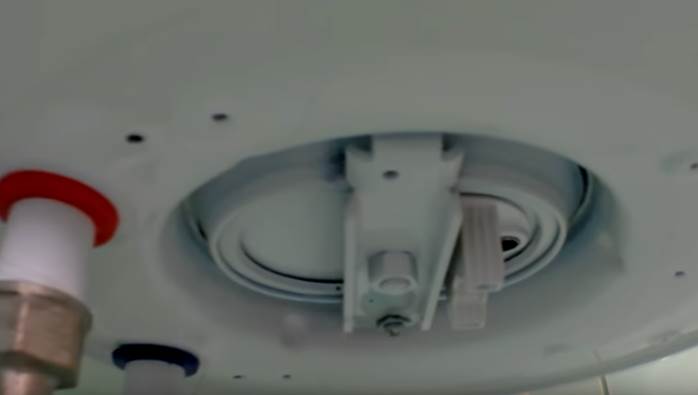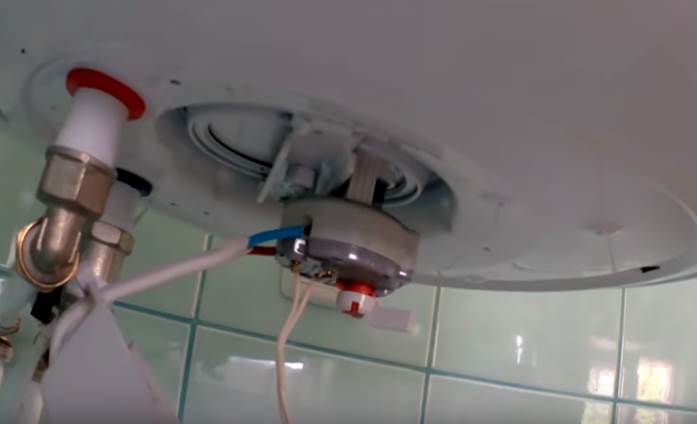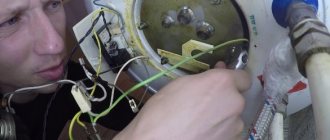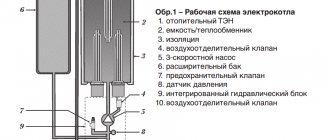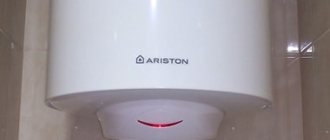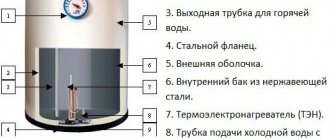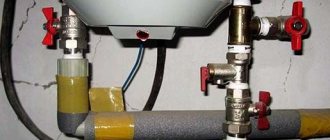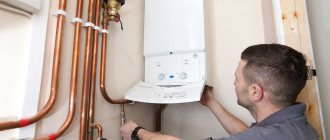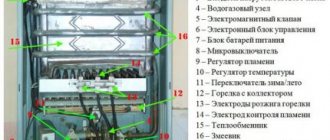Very often, during a move or when a malfunction occurs, people face a difficult task, because they need to disassemble a water heater. Do not forget that any boiler needs frequent regular cleaning and replacement of protection. In most cases, people do not want to overpay money or wait for a master, so they try to solve the problem on their own. Initially, it may seem that disassembling the boiler is quite a difficult task, but this is a misjudgment.
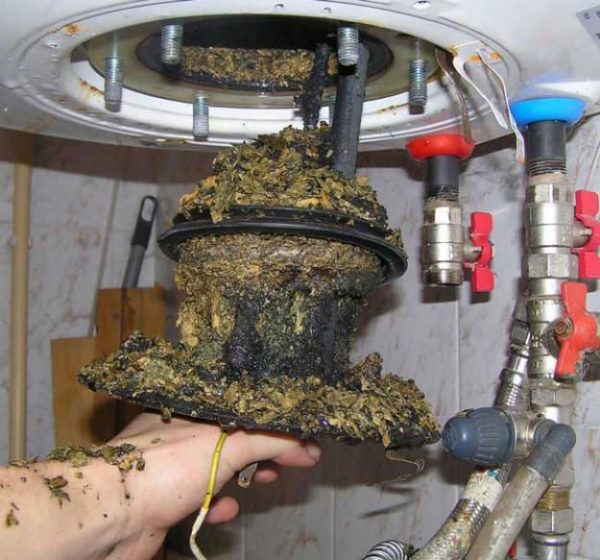
Boiler contamination
Analysis of water heaters of various brands
You can disassemble the device carefully, knowing the manufacturer and following clear step-by-step instructions.
Water heater Termeks
Since all water heaters have almost the same system, you might think that they need to be disassembled according to the same scheme. But manufacturers add some of their own details and functions, so each company has its own algorithm:
- Shut off the water supply. In most cases, there is a tap or valve under the boiler that must be closed.
- De-energize the boiler, after which it must be disconnected from the electricity.
- Use a flat-blade screwdriver to remove the protective cover. In some cases and on some models, it sits tightly, so you need to perform the movements that are made when you open the canned food.
- Use an indicator screwdriver to check if there is an electric current in the boiler. If everything is done correctly, the light in the screwdriver will not light up.
- Drain the water from the water heater, for this there is a step-by-step algorithm, which you can learn about by watching the video on various resources.
- Take a snapshot of the wiring diagram so that you do not confuse the wires later. After the shot, you can start disconnecting the wires.
- The nuts that secure the heating element and the thermostat should be unscrewed one at a time. This is necessary so that the water that has stagnated in the tank will gradually drain.
- Wipe the heating element and thermostat with a dry cloth.
The analysis is over.


Boiler diagram Termeks
Water heater Ariston
Procedure:
- De-energize the device by disconnecting it from the power supply.
- Remove the protective cover, which is secured with nuts.
- Next, you should disconnect three cables: 1 - phase, 2 - zero, 3 - ground. This is done using an indicator screwdriver. The first two wires free the thermostat, so you can easily pull it out of the tube.
Further, the algorithm for parsing the Ariston boiler is similar to the previously presented manufacturer.
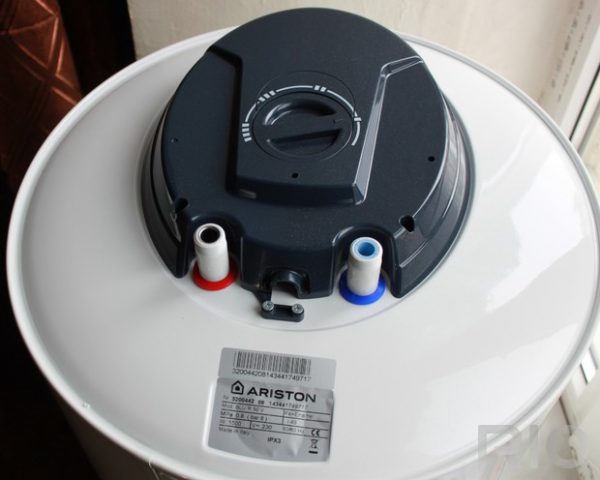

Protective cover
Water heater Polaris
In most cases, people tend to prefer Polaris boilers. The parsing order is as follows:
- Disconnect the boiler from the power supply.
- Drain the boiler. You need to get access to a tap that removes hot water from the reservoir.
- Next, you should disconnect the thermostat, in this case it is not fixed, but simply installed on the terminal block.
- The next step is to drain the remaining water from the tank.
- Unscrew the retaining bracket and remove the heating element from the storage tank at the correct angle.
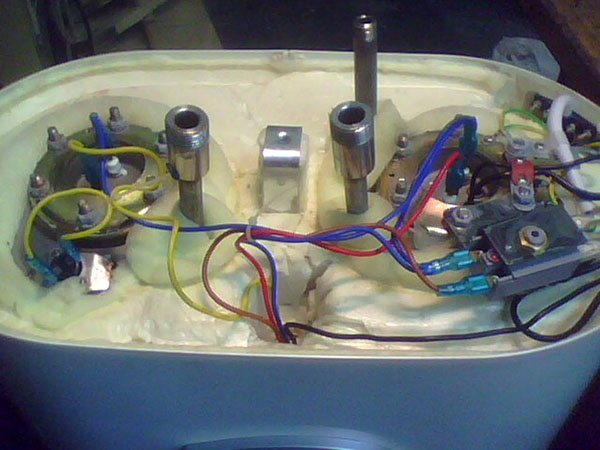

Polaris water heater diagram
Water heater Electrolux
Procedure:
- If the previous water heaters could not have been removed from the wall, then in this case it was impossible to do without it. Therefore, the first step in the algorithm is to remove the boiler from the wall. Before that, it is imperative to drain all the water from it.
- The removed boiler should be turned upside down with the fittings and the protective cover removed from it.
- Next, one by one, you need to start removing the thermostats, the thermometer's power supply, the thermometer itself, unscrew all the nuts to one, and eventually remove the heating element mounting flange.
- Then take out the heating element. Further actions depend on the reason for disassembling the boiler. If the device was disassembled due to a breakdown, then the heating element should be replaced, if the boiler just needed to be cleaned, then all parts should be wiped with a dry cloth and various contaminants, such as plaque and rust, should be removed.
Water heater Garanterm
Algorithm of actions:
- The first point of the algorithm for parsing the Garanterm water heater, as in most cases, is a power outage.
- Next, drain the water from the boiler. In order for the water to flow from the two taps and drain as much as possible, the common apartment tap should be turned off so that the water can flow out without problems.
- The next point is to work with different wires. We dismantle the terminals from the contacts of the heating element.
- We unscrew the screw with the grounding wire, then the screw for the power cord retainer, as well as the screw for the protective block.
- Remove all protection sensors and thermostat from the slot.
- Next, you need to unscrew the last five bolts, and start disassembling the insides and, for example, cleaning.
Water heater AQUAVERSO
The algorithm for parsing this water heater is very similar to the algorithm for parsing the Termeks boiler, which can be found at the beginning of the article. Only in this case, the water from the boiler must be drained immediately after the power is cut off.
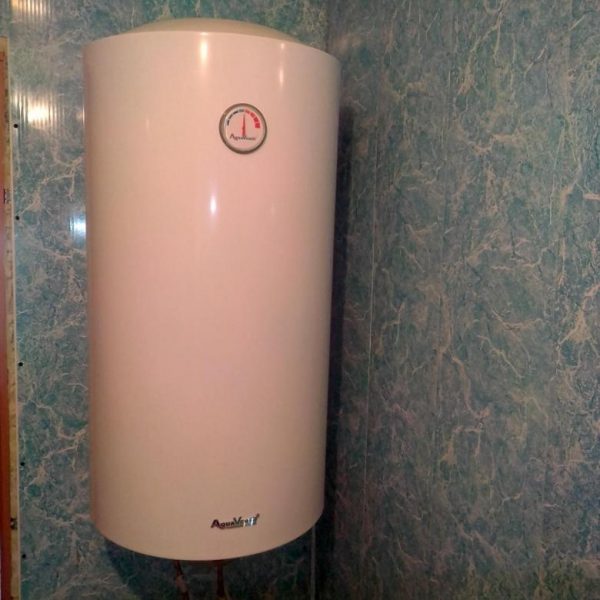

Boiler Aquaverso
Water heater Atmor
This type of water heater is not recommended to be repaired on your own, since the manufacturers have set it up so subtly that independent intervention can lead to severe damage and you will have to pay many times more money for repairs than for cleaning and disassembling.
There were cases when independent penetration into Atmor boilers led to a short circuit in the wiring, to fires, electric shock, or a complete breakdown of the water heater.
Superlux water heater
The SuperLuxe boiler can be disassembled using the Electrolux boiler disassembly diagram. These types are completely identical, therefore, parsing, installation and everything else are the same for them.
Water heater Goranje
Procedure:
- Disconnect the device from the mains.
- Drain the water heater.
- The first step is to remove the cover. In most cases, people cannot remove it and even break it, since it is plastic. It is very easy to remove it, pry it from the bottom with a screwdriver and push the front panel towards you.
- Next, pull the handle that regulates the temperature. Since the handle is not secured by anything, it will be quite simple to do this. Unscrew the two screws and the cover can be removed.
- The next step is to disconnect all the wires, it will be very difficult to get tangled in them, since they are all of different lengths and when assembled, each fits perfectly into its place.
- Next, you need to unscrew the flange, which is held by six nuts, and start cleaning the inside of the boiler.
Important! When cleaning the boiler and its components, in no case should you use sandpaper, brushes and much more, which can damage the surface. It is not necessary to rub every detail to a shine, and especially the inside of the boiler itself, scale on the walls of the water heater protects it from corrosion, so it is undesirable to get rid of it. Use a regular microfiber cloth to clean the parts.
Epico water heater
Algorithm of actions:
- First you need to disconnect the boiler from the network. Drain the water and remove the non-return valve.
- Remove the cover, which is secured with two bolts next to the pipes.
- Pull out the thermostat, it is very easy to do, you just need to slide it down. If the wires interfere, then they must be removed from the terminals.
- Next, you should drain the remaining water and scale into the container and you can get all the remaining parts.
Haier Water Heater
In this case, it is better to turn to professionals, since it is very problematic, and it will be difficult for an ordinary person to understand it.
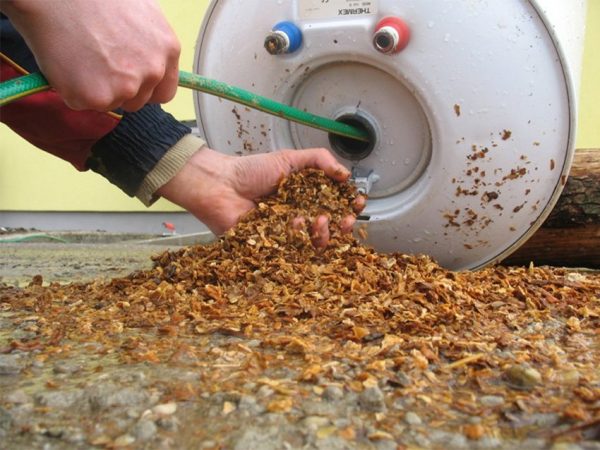

Cleaning the water heater
There is also a large number of other models of water heaters, for example, Timberk, Stiebel Eltron, AEG and many others. All of them differ from each other in something, size, color, complexity of the scheme.
Non-insulated coils in instantaneous water heaters
Uninsulated coils in storage water heaters pose a serious threat to human life. It is strictly forbidden to eliminate the malfunction of the heating element by simply winding the nichrome wire over the rod.
The design of an instantaneous water heater is fundamentally different from a storage water heater: there is no tank as such, the heating element is placed in a container slightly larger than the heating element itself, made of copper. The device is equipped with two degrees of protection: a thermostat that maintains the water temperature; a flow sensor that turns off the heating element when the water supply stops.
Electricity and water are no joke when it comes to human lives. It is forbidden, as they sometimes write, to place uninsulated nichrome spirals in copper tanks, which are often connected with copper pipes. This is called negligent homicide.
Finally, an argument to the readers! It is specially coated with nichrome ceramics to reduce scale formation. Metal is an unrivaled base for salt deposition. It is not accidentally supplied with an inert shell.
Tools for disassembling and collecting water heaters
To disassemble the device, a small number of tools are required, in most cases every person has them at home, so no additional costs will be required.
Before you start disassembling the water heater, you need to prepare all the tools in advance and lay them out in front of you, so that if something happens you will not be distracted by looking for this or that screwdriver.
List of required tools:
- Indicator screwdriver.
- Phillips and flat head screwdrivers (depends on the screws that screw the parts in).
- Adjustable wrench.
- A set of spanner keys.
- Knife and scissors.
- Tow.
- Microfiber cloth to wipe down the insides and parts.
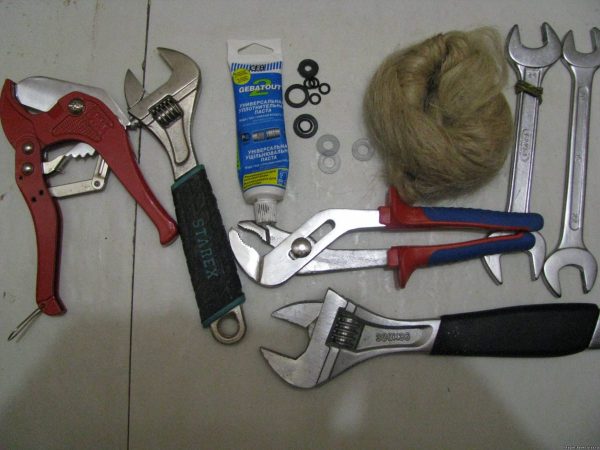

Required tools
Gas instantaneous water heaters
The devices require regular maintenance: lubrication of the internal valves to prevent gas and water leaks. Moving rods are periodically lubricated, rubber or silicone gaskets are replaced.
When carrying out work, the valves are closed. After processing, the nodes are washed to ensure the tightness of the joints.
When converting a water heater to a new type of gas, a trivial pressure adjustment does not give the desired result. We have to buy new components, for example, the ignition burner nozzle. Without additional adjustment, the water valve does not work correctly: a strong gas flow can depress the spring, and if there is no water supply, gas will continue to flow to the main burner.
The main plus of instantaneous water heaters is compactness. But at the same time, these household appliances consume a large amount of electricity. This is due to such a high power consumption, sometimes reaching 15 kW. Instantaneous water heaters belong to the class of reliable and durable devices, breakdowns rarely occur (sometimes due to a defect in production). You should know that repairing a flow-through water heater can be done by hand, it is enough to know the algorithm for finding them and purchase the necessary tools.
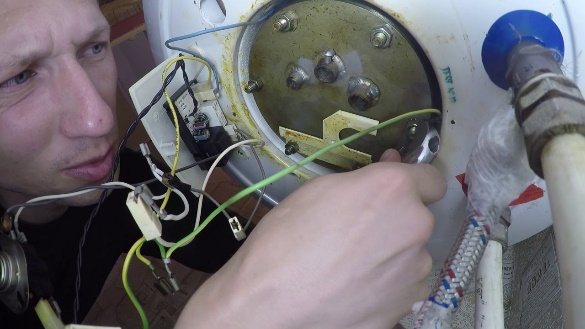

DIY water heater repair
Disassembly of the safety valve
The safety valve is an important thing in the operation of the water heater. This valve helps the water heater not to explode.It regulates the pressure inside, so you need to install it correctly so that when you turn on the boiler does not explode and starts working correctly, that is, to heat the water, and not just drive it through yourself.
Each boiler has its own individual valve, so a specialist should choose it.
The safety valve is like a simple piece of pipe with a small handle, with which the pressure inside the boiler will be regulated. The valve can be easily removed and installed back, but this must be done correctly in order to avoid breakage and other unpleasant situations.


Safety valve
Device and principle of operation
Do-it-yourself repair work is impossible without understanding the device and the principle of operation of the device, therefore, we will briefly consider what it represents and how the Termeks instantaneous water heater functions.
Device
The water heater consists of the following elements:
- Cold water inlet for connection to the water supply.

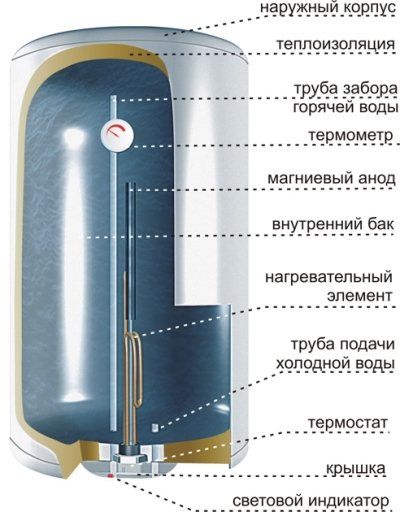
Tank (50L, 80L, 100L), coated with glass porcelain, which prevents the formation of scale and rust on its walls.- The vertical anode (magnesium pin) serves to inhibit corrosion of the heating element and other metal parts inside the tank.
- Flange is a steel fastening element on which the heating element, thermostat and anode are mounted. If necessary, it can be easily removed and provides access to replace defective parts.
- Hot water outlet.
- Thermostat with two degrees of protection - against overheating and dry start.
- The outer casing is made of high quality powder enamelled steel. Between it and the tank there is a heat-insulating layer that prevents water cooling.
Heater working principle
So how does it all work. The water entering the tank (from 50 liters) is heated with the help of a heating element and rises to the upper part, where the branch pipe for the intake of warm water is located.
When the intake tap is opened, for example, in the kitchen, the pressure in the tank decreases and cold water enters it through the inlet pipe, squeezing out the heated water through the intake. Cold water heats up and rises.
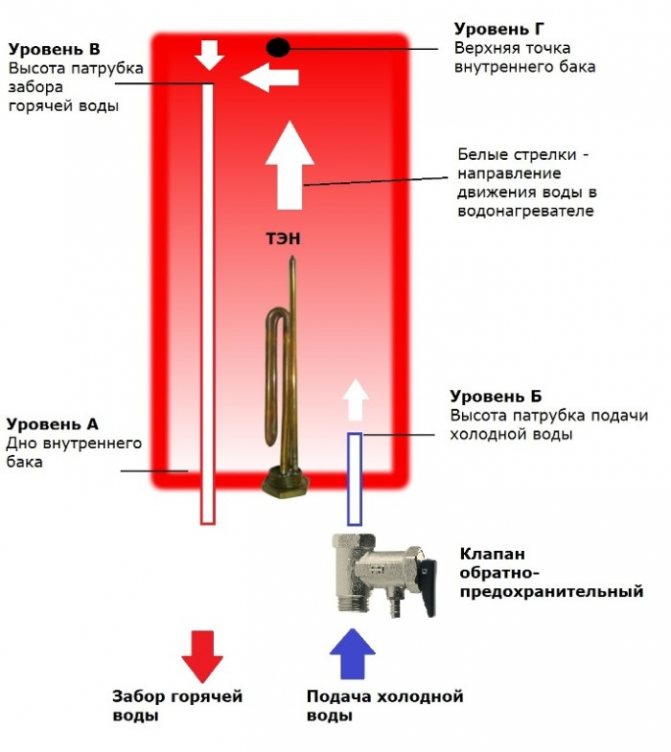

The principle of operation of the water heater
The temperature is regulated smoothly by means of a built-in thermostat within the range of up to + 75 ° C. The thermostat is designed in such a way that when the set temperature of the water in the tank is reached, it turns off the heating, and after the temperature drops by a few degrees below the set, it turns on, that is, automatically controls the process ...
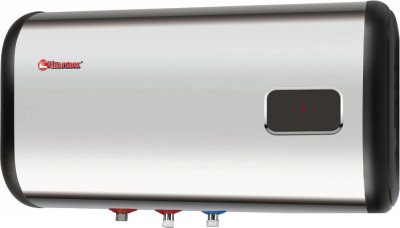

In addition, an emergency shutdown is provided if, for any reason, the water heats up to +80 - 85 ° C.
The interlayer between the inner tank and the outer casing is completely filled with polyurethane foam, with a thickness of 18 to 40 mm (depending on the model). Thanks to this, heat losses are minimal - about 1 degree in 2 hours.
The cathode takes on electrochemical corrosion and, thus, greatly extends the life of the heating element - the heating element, but at the same time it wears out faster and therefore, for the reliable operation of the entire water heater, it is necessary to regularly replace it with a new one. The estimated life of the cathode is 6 months of continuous use.
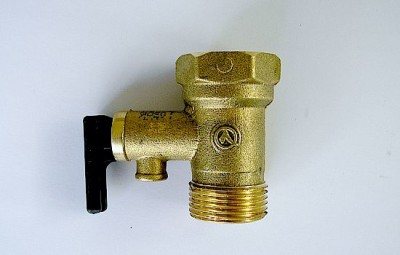

It is worth noting the mandatory presence of a check valve on the cold water inlet pipe, which performs safety functions. When the water supply to the water main is stopped, it will not allow water to pour into the pipe, in addition, it is a pressure regulator in the tank.
If the pressure exceeds the maximum allowable, it will be released through the drain hole of the valve. In the absence of a valve, dangerous deformation of the inner body is possible due to pressure drops in the water main and, at the same time, its accelerated corrosion.
Disconnection from the mains
An important and main element of disassembling a water heater is to disconnect it from the electrical network.It is simply necessary to do this, since the safety of not only the one who disassembles the boiler depends on it, but also of all those nearby, because if the boiler explodes, then the losses will be significant.
Even when the device is disconnected from the power supply, it is necessary to check the presence of current in the wires using an indicator screwdriver, since when the water is drained, the wires may short-circuit and a fire will start.
Dismantling the water heater, cleaning it inside or repairing it will not be difficult if you follow the clear instructions that are attached in a special book. If the documents for the boiler are lost, then the parsing algorithm can be found on the Internet in various forms: in written, exemplary, etc. But do not forget that there are also such models of boilers, penetration into which is possible only by a specialist, since the developers have made the internal system difficult for ordinary people to understand.
Basic control systems for instantaneous water heaters
Before proceeding with the repair of an instantaneous water heater with your own hands, you should understand its structure and principle of operation. The main elements of an instantaneous water heater:
- Heating element - heating element.
- Pressure switch.
- Temperature sensor.
In addition, the circuit must have wires with different markings, as well as a button to turn on the device and adjust the water temperature (in more expensive models). Manufacturers of water heaters very often use a standard control scheme, including new elements in it.
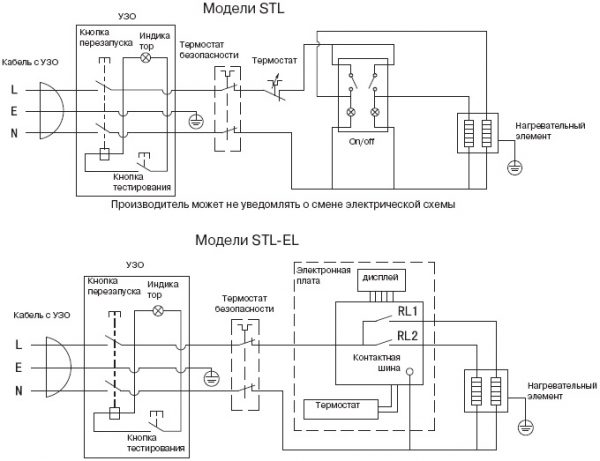

2 water heater control schemes
Above are the diagrams of devices of different models of instantaneous water heaters. As you can see, in these water heaters, heating elements are provided, to which the electric current passes through a temperature control relay, a pressure switch and a switch. Both relays in the circuit have a protective function, and trip the network if any of the parameters are not correct. The switch is used to adjust the working power of the device.
The lower circuit is additionally equipped with an electronic board that controls the device. In both schemes, a residual current device is provided
In addition to the phase and neutral conductors, a ground connection is also provided here. The circuit is simple, you can connect it yourself using an indicator screwdriver to determine the incoming phase and zero.
Thermex water heater control circuit
The above scheme is practically no different from the previous one. A slightly different arrangement of the element, but the functionality remains the same. 2 heating elements allow you to heat the liquid more or less. The relay is responsible for their operation, the signal to which is sent by the previously installed thermostat.
An additional element in this circuit is the readout sensor, which is connected to the relay. The heating elements can be turned on in automatic mode.
Conclusions and useful video on the topic
A detailed video on condition diagnostics, maintenance and self-repair of domestic water heaters can be viewed here:
It is not so difficult to repair a water heater when it comes to replacing some of its elements. In the event of a serious breakdown, it would be wiser to contact a specialized service center. Correct use of the device and its timely maintenance will save you many problems and costs.
You have been repairing water heaters for a long time and want to supplement our material with useful tips and professional secrets for eliminating various kinds of breakdowns? Or is it the first time you encountered a malfunction and cannot find its cause in any way? Write your comments, ask questions, share your opinion below the article.
Review of a compact electric water heater in the form of a tap - characteristics and cost. The electric nozzle on the faucet for heating water is a kind of portable water heater: the faucet is installed and dismantled in a couple of minutes, so that if necessary, take its place again, when it is convenient to wash the dishes or take a shower under warm water by other methods for some reason is not possible ...
What is thermal protection in an instantaneous water heater
Instantaneous water heaters are equipped with thermal protection elements - temperature control sensors. If the sensor malfunctions, the water in the device quickly reaches a high temperature, and the pressure increases accordingly. Both the water heater itself and the heating elements - heating elements - can be damaged.
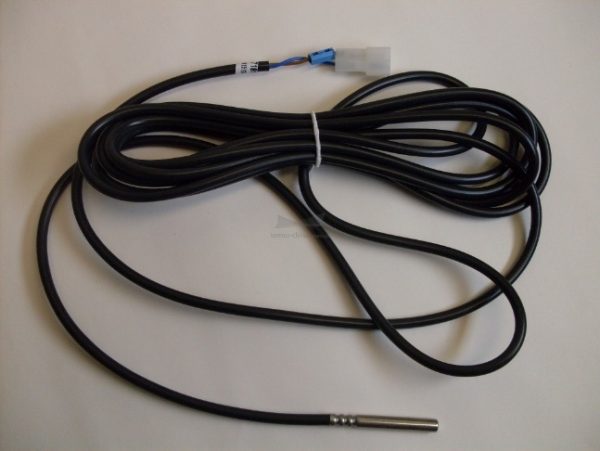

Example of a temperature sensor for a boiler
The temperature control sensor works by interrupting the electrical circuit when a certain water temperature is reached. The most common overheating sensor (both electric and gas) is triggered at 60 ° C. After which the water cools down, the sensor turns on the electrical circuit, and the heating of the liquid begins anew.
In addition to the main sensor that monitors the temperature, an additional one is also installed. It carries the function of back-up shutdown of the circuit if the main sensor does not work. The reserve element will open the circuit at 90 ° C. It should be remembered that the backup sensor must be switched on manually, as it does not work in automatic mode. Usually it is turned on by replacing the main one.
How to replace a temperature sensor
The temperature sensor is usually installed as close as possible to the water outlet. Attaches to body with four bolts or Allen screws. Some models of thermal sensors have a collapsible housing, which allows you not to buy a new sensor, but to restore the old one yourself.
Temperature sensor replacement procedure:
- Drain the water.
- Remove four bolts or screws. For screws, you need to use a hexagon or a shaped screwdriver, for bolts, a suitable wrench.
- Remove the wires, having previously marked them with a marker. The wire is attached to the sensor terminals with screws. It should be remembered that before starting work, the water heater must be disconnected from the network.
- Remove the old sensor and install a new one in its place, fasten with bolts or screws. It is necessary to purchase exactly the same item, otherwise the attachment points may not match.
- Connect the wires and tighten the contact points properly.
- Fill in water and turn on the water heater. Check its functioning.
We repair a flowing water heater ourselves
And are there any analogs to these dividers? Or just the original search? All sections Instructions About the site Contacts Earn. Reviews and comments. Prevention as a way to avoid problems It is not only home owners who provide themselves with autonomous hot water. Drain Since a high-quality drain is the key to a successful outcome of the entire operation, we will dwell on it in more detail. He will have to unscrew it with an adjustable wrench and drain all the water.
You can bend it, fix it and wait for all the water to drain. This process usually takes 1 hour. Before that, connect the hose to the water outlet and drain. How to properly disassemble the boiler?
